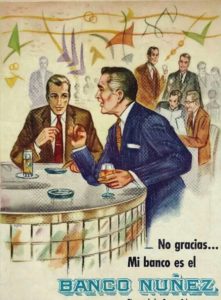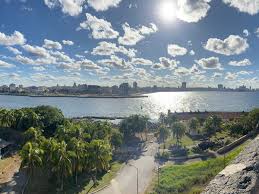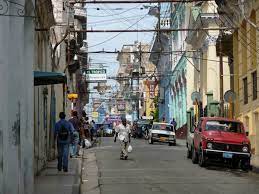EL BANCO NÚÑEZ, CUBA. HISTORIA DE CARLOS NÚÑEZ, DE BODEGUERO A MILLONARIO. PHOTOS.
Si una historia merece ser contada cuando se recuerdan las grandes fortunas que existieron en la Cuba de ayee antes de 1959 es la de Carlos Núñez Pérez que, de bodeguero y carretonero de caña, llegó a convertirse en uno de los hombres más ricos del país.
Carlos Núñez Pérez fue el empresario cubano, entre los nacidos en la primera mitad el siglo XX, que levantó la mayor fortuna; sin valerse para ello de caudales heredados, lazos familiares o relaciones políticas y con apenas una elemental instrucción primaria.
DE DEPENDIENTE DE BODEGA A MILLONARIO
Era hijo de Arsenio Núñez Quintero, un español de origen humilde, y la cubana Domitila Pérez Almaguer. Su padre se había dedicado a explotar un pequeño fundo platanero en Samá y más tarde se había instalado en una colonia del central Santa Lucía.
Carlos nació en Holguín el 4 de noviembre de 1885 y a los 15 años comenzó a trabajar como dependiente de una bodega y de una tienda mixta en Gibara, Oriente. Posteriormente de carretonero de caña y mayoral en la colonia de su padre, hasta que se compró a crédito por $90 000 su primera colonia, la Bariay, y sucesivamente fue adquiriendo otras hasta acumular en 1918 un capital de $800 000.
De manera casi fortuita giró hacia el negocio bancario, en pleno crack, cuando nadie daba un peso por el negocio de la banca en Cuba y las entidades financieras quebraban una tras otra.
En ese entonces, Carlos atendía sus colonias de caña en el central Santa Lucía donde tenía fama de tener mano de Midas. Como eran tiempos económicos difíciles y tenía tan buen tino para los negocios todos los particulares y empresarios de la zona acudían a él en busca de consejo antes de emprender cualquier empeño mercantil y dejaban bajo su custodia fuertes sumas de dinero.
Fue así que se decidió a dar el salto y el 21 de marzo de 1921 en Santa Lucía, Holguín, fundó un pequeño banco que sería el embrión de una de las empresas cubanas más rentables, con utilidades de más de $1 000 000: el Banco Núñez.
Poco a poco fue extendiendo sus operaciones y ganando prestigio hasta que en febrero de 1932 abrió en Gibara la primera sucursal de su banco. Meses después abrió otra en la ciudad de Holguín, a la que siguieron rápidamente las de Las Tunas, Palma Soriano, Bayamo, Guantánamo y Santiago de Cuba.
CARLOS NUÑEZ LLEGA A LA HABANA
El 19 de marzo de 1939 trasladó sus oficinas para La Habana y lo convirtió en banco nacional. Tres años después, el 1ro de julio de 1942 lo reestructuró como una sociedad anónima donde los accionistas fueron siempre él y sus siete hijos.
En 1958 el Banco Núñez era el 4to banco comercial y nacional del país por sus depósitos ascendentes a $97 000 000 y tenía 22 sucursales. Su oficina central estaba en la calle Mercaderes No. 260 en La Habana. En 1957 fue seleccionado por “The American Bankers” como uno de los 500 más importantes del mundo.
Desde la banca Núñez comenzó a diversificarse a la industria, los servicios y los bienes raíces:
El 11 de junio de 1956 se adjudicó por vía de un remate judicial el central Algodonal, un pequeño ingenio azucarero, situado en Alto Songo, Oriente. El propietario del central Zoilo Marinello Vidaurreta (hermano de Juan, presidente del PSP) desde 1940 arrastraba deudas con el banco que no había podido saldar.
Como forma de pago de un préstamo no saldado a su banco se había apropiado también de una parte de las acciones de la “Compañía Maderera de Nipe SA”, un aserrío de madera en Antilla, Oriente.
Poseía, además, varias firmas inmobiliarias: “Compañía Inmobiliaria Nescar SA”, una firma de parcelación de terrenos; la “Inmobiliaria Ceabanú SA” y la “Compañía Inmobiliaria Norka SA”.
También era propietario de la “Compañía Comercial Marítima SA” que administraba la Zona Franca del Puerto de Matanzas. Esta firma tenía dos subsidiarias: “Compañía Industrial de la Zona Franca de Matanzas” y los “Almacenes del Puerto de Matanzas SA”; la primera dedicada a la explotación de la Zona Franca y la segunda con almacenes y depósitos.
UNA VIDA PLENA
A lo largo de su vida Carlos Núñez desarrolló una amplia actividad social y corporativa: Fue Gran Tesorero de la Gran Logia Masónica desde 1950 y era miembro del Consejo de Dirección de la Universidad Nacional Masónica José Martí. El banquero era el más importante y acaudalado empresario que existía entre los masones cubanos.
En 1958 era vocal del Grupo de Transporte de la Cámara de Comercio de la República de Cuba y de la Asociación de Propietarios del Reparto Miramar. Durante algunos años fungió como vicepresidente del Havana Clearing House.
Estaba casado desde 1908 con Concepción Gálvez Varela y tenía siete hijos que ocupaban cargos en el banco: Carlos, el mayor, era vicepresidente; Emilia, tesorera; Domitila, vicetesorera; Francisca, vocal; Ernesto, vicepresidente segundo; y Blanca, Norma y Pura eran vocales. Sus hijos tenían, además, cargos de importancia en las otras empresas que controlaba el banco.
Vivía en Ramón Mendoza No. 1410 entre 14 y 18, Alturas de Miramar y pertenecía a varios de los más selectos clubes de la época como el Casino Español de la Isla de Cuba y el Club La Torre, con sede en uno de los penthouse del edificio FOCSA.
ULTIMOS AÑOS DE CARLOS NUÑEZ.
Octubre de 1960 fue un mes terrible para Carlos Núñez. Hacía casi dos años que la Revolución había triunfado y no hacía más que radicalizarse. De boca en boca corrían rumores inquietantes de que la banca cubana sería nacionalizada. Por esa razón, y a pesar de tener ya casi 75 años, el banquero se encaminó al Palacio Presidencial junto al dueño del Banco Agrícola e Industrial y se entrevistó con Luis Buch Rodríguez, Ministro de la Presidencia, con quien mantenía muy buenas relaciones de negocios desde antes de 1959. Le pidió entonces al ministro que le contara la verdad sobre lo que se cocinaba desde el Gobierno.
Luis Buch lo tranquilizó diciéndole que no había ningún problema y que el Gobierno sólo estaba estudiando el tipo de relación que tendrían en el futuro de los bancos cubanos privados con el Banco Nacional de Cuba.
El 13 de octubre el Consejo de Ministros decretó la nacionalización de la banca privada y todo el trabajo de la vida de Carlos Núñez Pérez se acabó con una firma.
Como compensación el Banco Nacional de Cuba le ofreció la cantidad de 10 000 pesos… que no aceptó.
El Banco Nuñez era propiedad única de Don Carlos Núñez y Doña Pura Galvez.
Carlos Núñez Pérez, fue su único dueño y Presidente. La pareja tuvo siete hijos, Carlos, Emilia, Domitila, Francisca, Néstor, Blanca y Norma Núñez Gálvez.
Carlos Núñez and his wife left Cuba in 1961, Carlos died on October 31, 1979.
THE NÚÑEZ BANK, CUBA. HISTORY OF CARLOS NÚÑEZ, FROM WAREHOUSE CLERK TO MILLIONAIRE. PHOTOS.
If a story deserves to be told when the great fortunes that existed in the Cuba of Ayee before 1959 are remembered, it is that of Carlos Núñez Pérez who, from a winery and cane trucker, became one of the richest men in the country.
Carlos Núñez Pérez was a Cuban businessman, among those born in the first half of the 20th century, who raised the greatest fortune; without making use of inherited wealth, family ties, or political relationships and with barely an elementary primary education.
FROM WAREHOUSE DEPENDENT TO MILLIONAIRE
He was the son of Arsenio Núñez Quintero, a Spaniard of humble origins, and the Cuban Domitila Pérez Almaguer. His father had dedicated himself to operating a small banana plantation in Samá and had later settled in a neighborhood in the Santa Lucía sugar mill.
Carlos was born in Holguín on November 4, 1885 and at the age of 15 he began working as a clerk in a winery and a mixed store in Gibara, Oriente. Later, he was a cane trucker and foreman in his father’s colony, until he bought his first colony, Bariay, on credit for $90,000, and successively acquired others until he accumulated a capital of $800 in 1918. 000.
In an almost fortuitous way, he turned to the banking business, in the middle of the crack, when nobody gave a peso for the banking business in Cuba and financial institutions went bankrupt one after another.
At that time, Carlos tended his sugarcane colonies in the Santa Lucía sugar mill, where he was famous for having the hand of Midas. As these were difficult economic times and he had such a good sense for business, all individuals and businessmen in the area came to him for advice before undertaking any commercial endeavor and left large sums of money in his custody.
It was thus that he decided to take the leap and on March 21, 1921, in Santa Lucía, Holguín, he founded a small bank that would be the embryo of one of the most profitable Cuban companies, with profits of more than $1,000,000: Banco Nunez.
Little by little he was expanding his operations and gaining prestige until in February 1932 he opened the first branch of his bank in Gibara. Months later he opened another in the city of Holguín, which was quickly followed by those in Las Tunas, Palma Soriano, Bayamo, Guantánamo and Santiago de Cuba.
CARLOS NUÑEZ ARRIVES IN HAVANA
On March 19, 1939, he moved his offices to Havana and turned them into a national bank. Three years later, on July 1, 1942, he restructured it as a corporation where the shareholders were always him and his seven children.
In 1958 Banco Núñez was the 4th commercial and national bank in the country for its deposits amounting to $97,000,000 and had 22 branches. Its central office was at Calle Mercaderes No. 260 in Havana. In 1957 he was selected by “The American Bankers” as one of the 500 most important in the world.
From banking Núñez began to diversify into industry, services, and real estate:
On June 11, 1956, he was awarded the Algodonal mill, a small sugar mill, located in Alto Songo, Oriente, through a judicial auction. The owner of the Zoilo mill Marinello Vidaurreta (Juan’s brother, president of the PSP) since 1940 had debts with the bank that he had not been able to settle.
As a form of payment for an unpaid loan to his bank, he had also appropriated part of the shares of the “Compañía Maderera de Nipe SA”, a lumber mill in Antilla, Oriente.
He also owned several real estate firms: “Compañía Inmobiliaria Nescar SA”, a land division firm; “Inmobiliaria Ceabanú SA” and “Compañía Inmobiliaria Norka SA”.
He was also the owner of the “Compañía Comercial Marítima SA” that administered the Free Zone of the Port of Matanzas. This firm had two subsidiaries: “Compañía Industrial de la Zona Franca de Matanzas” and the “Almacenes del Puerto de Matanzas SA”; the first dedicated to the exploitation of the Free Zone and the second to warehouses and deposits.
A FULL LIFE
Throughout his life Carlos Núñez developed a wide social and corporate activity: he was Grand Treasurer of the Masonic Grand Lodge since 1950 and was a member of the Board of Directors of the José Martí National Masonic University. The banker was the most important and wealthy businessman that existed among the Cuban Freemasons.
In 1958 he was a member of the Transport Group of the Chamber of Commerce of the Republic of Cuba and of the Association of Owners of the Miramar District. For a few years, he served as vice president of the Havana Clearing House.
He had been married to Concepción Gálvez Varela since 1908 and had seven children who held positions in the bank: Carlos, the eldest, was vice president; Emily, treasurer; Domitila, vice treasurer; Francisca, vocal; Ernesto, second vice president; and Blanca, Norma, and Pura were vocal. His children also held important positions in the other companies controlled by the bank.
He lived at Ramón Mendoza No. 1410 between 14 and 18, Alturas de Miramar, and belonged to several of the most select clubs of the time such as the Casino Español de la Isla de Cuba and Club La Torre, based in one of the penthouses of the FOCSA building.
LAST YEARS OF CARLOS NUÑEZ.
October 1960 was a terrible month for Carlos Núñez. It had been almost two years since the Revolution had triumphed and it had only become more radical. Disturbing rumors circulated by word of mouth that the Cuban banks would be nationalized. For this reason, and despite being almost 75 years old, the banker went to the Presidential Palace together with the owner of Banco Agrícola e Industrial and met with Luis Buch Rodríguez, Minister of the Presidency, with whom he had had very good business relations since before 1959. He then asked the minister to tell him the truth about what the government was cooking.
Luis Buch reassured him by saying that there was no problem and that the government was only studying the type of relationship that private Cuban banks would have with the Banco Nacional de Cuba in the future.
On October 13, the Council of Ministers decreed the nationalization of private banking and all the work of Carlos Núñez Pérez’s life ended with a signature.
As compensation, the Banco Nacional de Cuba offered him the amount of 10,000 pesos… which he did not accept.
Banco Nuñez was the sole property of Don Carlos Núñez and Doña Pura Galvez.
Carlos Núñez Pérez was its sole owner and President. The couple had seven children, Carlos, Emilia, Domitila, Francisca, Néstor, Blanca and Norma Núñez Gálvez.
Carlos Núñez and his wife left Cuba in 1961, Carlos died on October 31, 1979.
Agencies/ Cuba: SuHistoria/ Nekubu Héritier/ Extractos/ Excerpts/ Internet Photos/ Arnoldo Varona/ www.TheCubanHistory.com
THE CUBAN HISTORY, HOLLYWOOD.



 THE NUÑEZ BANK, Cuba. History of Carlos Nuñez, from Clerk to Millionaire. PHOTOS. * EL BANCO NUÑEZ, Cuba. Historia de Carlos Nuñez, de Bodeguero a Millonario. PHOTOS.
THE NUÑEZ BANK, Cuba. History of Carlos Nuñez, from Clerk to Millionaire. PHOTOS. * EL BANCO NUÑEZ, Cuba. Historia de Carlos Nuñez, de Bodeguero a Millonario. PHOTOS.







